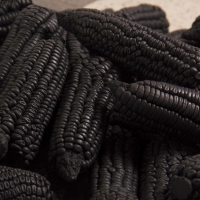Erster Gewinner des TASA Preises, den die Stiftung kunst:raum sylt
quelle zusammen mit der
Turbine Hall Art Fair (TAF) in Johannesburg
vergibt, ist der Südafrikaner Setlamorago Mashilo, genant "Mash", mit
seiner Skulptur aus Beton und Stoff "Mabu a u twitstwe": 500 schwarze
Maiskolben aus Beton liegen auf einer Decke und symbolisieren den
ungerechten Kampf um Land, der auch im neuen Südafrika Subsistenzfarmer
bedroht und altes Unrecht einfach durch neues ersetzt. Zugleich ist
diese Skulptur eine Hommage an den Großvater Mashilos, der sich
zeitlebens gegen diese Enteignung widersetzt hatte.
Der Jury des
TASA Preises gehörten an: Glynis Hyslop (Direktorin/Initiatorin der
TAF), Usha Seejarim (Künstlerin/Südafrika), Warren Siebrits (Galerist,
Kunstexperte, Sammler/Südafrika), Indra Wussow (Stiftung kunst:raum sylt
quelle, Kuratorin und Literaturwissenschaftlerin).
Biography
26 year old Installation artist Setlamorago Mashilo is a trained visual
artist who lives and works in Pretoria. He graduated High School in 2005
and his development as an artist was profoundly influenced by his
introduction to postmodern theory and his Sepedi upbringing. Mashilo
works in various media including drawing, sculpture and printmaking.
Artist Statement
I employ the use of 'dika le diema' (Sepedi Proverbs and Idioms) which
incorporate objects, images, stories and songs inherited from my
collective Sepedi upbringing. As a result, I unpack my own spiritual and
psychological connections with these established systems of thought or
ideologies and how they still condition our contemporary lives – the
very same systems created by previous generations to secure our being
and give them what we/they seek from life.
What takes place in my
work is a strange monologue – recited, sung – scenes and acts that are
eerily fateful and transcendent, stories that resonate individually and
collectively about our sense of loss, nostalgia and inherited memories
and the future. My work becomes one form of me talking about how the
values of our societies are deeply encoded in these stories and how that
extrapolates into the communities we grow up in.
The series '
Mabu a u tswitswe'
The
thorny issue come discourse concerning land in South Africa has always
been a contentious dialogue to engage with. There are seemingly new
complexities that emerge with the interrogation of this subject as there
is a collective understanding that the land was stolen from the
indigenous people(s) who occupied it. This view still persists in South
Africa’s contemporary society to the extent where it expands to politics
and economics. The year 2013 marked the 100th year anniversary of the
Native land act. Thus beckons the questions, what permutations exist due
to this happening? What types of connection[s] are there between the
land and it’s "'custodians'"?
The series titled '
Mabu a u tswitswe',
is engrossed in exploring these potent questions and analysing the
multi-faceted narratives that inform our historical and contemporary
lives. The title is in fact a Sepedi idiom which literally means ‘the
land has been stolen’. I critique various narratives that resonate
collectively with the greater public such as issues of migration,
labour, dispossession, alienation, angst etc. Inversely, I also
interrogate my own spiritual/ psychological alienation and angst towards
the lands which I occupy.
Weitere Informationen zum gemeinsamen Preis der Turbine Hall Art Fair und der Sylt Foundation TASA
hier.
Zurück zur Übersicht der von der Stiftung kunst:raum sylt quelle vergebenen
Stipendien und Preise.



